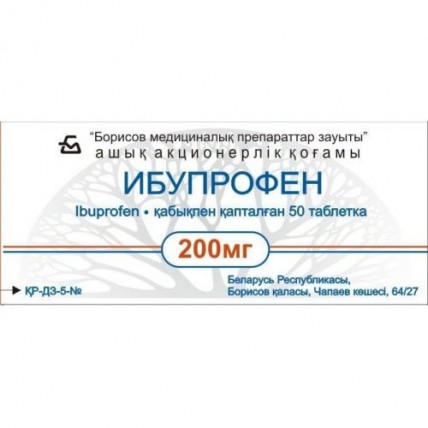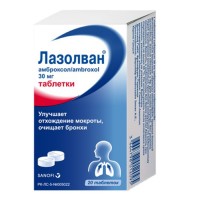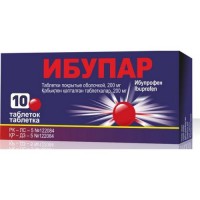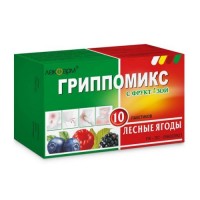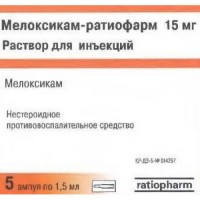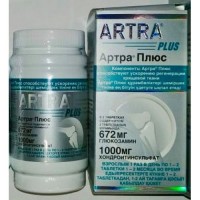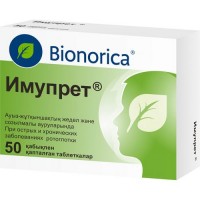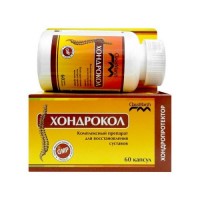Ibuprofen 200 mg coated (10 tablets)
- $2.50
Out Of Stock
The instruction for medical use
of medicine
An ibuprofen
the Trade name
the Ibuprofen
the International unlicensed
name Ibuprofen Dosage Form
of the Tablet, coated 200 mg
Structure
One tablet contains
active agent an ibuprofen of 200 mg
excipients: potato starch, magnesium stearate, calcium stearate, povidone, opadray (dioxide (E 171) contains the polyvinyl alcohol which is partially hydrolyzed, talc, a macrogoal 3350, lecithin, the titan).
The description
of the Tablet of round shape, with a biconvex surface, coated white color.
Pharmacotherapeutic group
Nonsteroid anti-inflammatory and antirheumatic drugs. Non-steroidal anti-inflammatory drugs. Propionic acid derivatives. The ibuprofen
the ATX M01AE01 Code
The pharmacological
Pharmacokinetics Later properties of intake bioavailability of an ibuprofen makes 80%. The maximum concentration of an ibuprofen in blood plasma after intake is on an empty stomach reached in 0.45 1 h, at reception after a meal in 2,0 2,5 h. The maximum concentration of an ibuprofen in synovial fluid is reached in 3 h. Therapeutic concentration of an ibuprofen in plasma makes 10 50 mkg/ml, toxic 100,700 mkg/ml. It is metabolized in a liver with formation of 3 inactive metabolites. The biological activity of an ibuprofen is connected with S-enantiomerom. After absorption about 60% pharmacological of an inactive R-form are slowly transformed to an active S-form.
In blood the ibuprofen reversibly contacts proteins of plasma (about 90 99%). The ibuprofen slowly gets into a cavity of joints, is late in synovial fluid. Concentration of an ibuprofen in synovial fluid big, than in plasma. The volume of distribution is 0.1 l/kg.
60 90% of the entered dose are removed by kidneys with urine in the form of metabolites, to a lesser extent removed with bile. Excretion of not changed ibuprofen is less than 1%. The period of semi-elimination of an ibuprofen is 2 2,5 h, the general clearance 0.75 & plusmn, 0.20 ml/min.
At elderly patients the pharmacokinetics of an ibuprofen does not change.
The pharmacodynamics
the Ibuprofen is a non-steroidal anti-inflammatory drug (NPVP). Has anti-inflammatory, analgeziruyushchy and febrifugal effect. The mechanism of action consists in not selective oppression of activity tsiklookigenazy-1 and 2 that leads to suppression of synthesis of prostaglandin and interferes with release of mediators of inflammation. As a result the ibuprofen reduces the pain caused by inflammation, hypostasis and temperature increase.
Indications
- a pain syndrome of various etiology: a sore throat, a headache, migraine, a toothache, neuralgia, bone and articulate and muscular pains, postoperative pains, posttraumatic pains, algodismenoreya
- a feverish syndrome in flu, catarrhal and other infectious and inflammatory diseases
- inflammatory and degenerative diseases of joints and a backbone (including the pseudorheumatism ankylosing a spondylitis).
The route of administration and doses
of the Pill are taken (without chewing) in time or after meal.
For adults and children from 12 years the ibuprofen is appointed on 200 mg by 34 times a day. For achievement of fast therapeutic effect at adults the dose can be increased up to 400 mg (2 tablets) 3 times a day.
Not to take more than 6 pill in 24 hours.
Interval between reception of tablets not less than 6 hours, maximum daily dose of 1200 mg.
If at administration of drug within 23 days the symptoms remain, it is necessary to stop treatment and to see a doctor.
Side effects
At use of the drug Ibuprofen within 23 days side effects are practically not observed. In case of prolonged use the emergence of the following side effects is possible:
- a headache, dizziness, insomnia, excitement, drowsiness, a depression, confusion of consciousness, a hallucination
- nausea, pain and sensation of discomfort in epigastriums, abdominal pains
- vomiting, heartburn, diarrhea, a constipation, a meteorism
- a bronchospasm, an asthma
- skin rash, an itching, a small tortoiseshell
- digestive tract erosive cankers (in some cases are complicated by perforation and bleeding), irritation, dryness of a mucous membrane of an oral cavity or mouth pain, an ulceration of a mucous membrane of gums, aphthous stomatitis, anorexia, pancreatitis, hepatitis
- heart failure, increase in the arterial blood pressure (ABP), tachycardia
- aseptic meningitis (is more often at patients with autoimmune diseases)
- a Quincke's edema, anaphylactoid reactions, an acute anaphylaxis, fever, a multiformny exudative erythema (century of t. h StivensaDzhonson's syndrome), a toxic epidermal necrolysis (Lyell's disease), an eosinophilia, allergic rhinitis
- anemia (including hemolytic, aplastic), thrombocytopenia and a Werlhof's disease, an agranulocytosis, a leukopenia
- a nephrotic syndrome (hypostases), an acute renal failure, allergic nephrite, a polyuria, cystitis
- decrease in hearing, a ring or sonitus, a reversible toxic optic neuritis, illegibility of sight or a diplopia, dryness and irritation of eyes, hypostasis of a conjunctiva and a century (allergic genesis), scotoma
- strengthening of sweating
At prolonged use in high doses an ulceration of a mucous membrane of a digestive tract, bleeding (gastrointestinal, gingival, uterine, hemorrhoidal), disorders of vision (disturbance of color sight, scotoma, an amblyopia).
At emergence of side effects it is necessary to stop administration of drug and to see a doctor.
Contraindications
- deficit glyukozo-6-fosfatdegidrogenazy,
- hypersensitivity to an ibuprofen,
- digestive tract erosive cankers in an aggravation phase,
- gastrointestinal and other bleedings,
- aspirinovy asthma and an aspirinovy triad,
- hemorrhagic diathesis (angiohemophilia, a Werlhof's disease, telangiectasias), a prothrombinopenia, hemophilia,
- the stratifying aortic aneurysm,
- portal hypertensia,
- deficiency of vitamin K,
- pregnancy and the period of a lactation,
- diseases of an optic nerve, scotoma, an amblyopia, disturbance of color sight,
- arterial hypertension, heart failure of the III-IV stage on NYHA,
- pathology of a vestibular mechanism, decrease in hearing,
- a heavy renal and liver failure,
- children's age up to 12 years.
Medicinal interactions
Non-steroidal anti-inflammatory drugs can reduce effect of antihypertensive drugs, such as angiotensin-converting enzyme inhibitors, beta-blockers and diuretics. Diuretics can also increase risk of nephrotoxicity of non-steroidal anti-inflammatory drugs.
Non-steroidal anti-inflammatory drug can aggravate heart failure, reduction in the rate of glomerular filtration and increase in plasma concentration of cardiac glycosides.
Holestiramin at co-administration with an ibuprofen can reduce absorption of an ibuprofen in digestive tract.
Co-administration with salts of lithium leads to decrease in excretion of lithium.
Non-steroidal anti-inflammatory drugs can inhibit canalicular secretion of a methotrexate and reduce clearance of a methotrexate.
Cyclosporine: the increased risk of nephrotoxicity.
Mifepristone: decrease in efficiency of medicine, can theoretically happen because of antiprostaglandinovy effect of non-steroidal anti-inflammatory drug. Limited data demonstrate that joint administration of non-steroidal anti-inflammatory drugs in day of administration of prostaglandin has no negative impact on influence of mifepristone or prostaglandins on maturing of a neck of the uterus and does not reduce clinical performance of medicinal termination of pregnancy.
Other analgetics and selection inhibitors of cyclooxygenase-2: it is recommended to avoid simultaneous use of two or more non-steroidal anti-inflammatory drugs, including TsOG-2 inhibitors as it can increase risk of development of side effects.
Acetylsalicylic acid: simultaneous use of an ibuprofen and acetylsalicylic acid is not recommended because of possible increase in side effects, including, increases in risk of gastrointestinal ulcers or bleedings. Experimental data demonstrate that the ibuprofen can suppress effect of low doses of acetylsalicylic acid on aggregation of thrombocytes when they are dosed at the same time.
Anticoagulants: NPVP can strengthen effect of anticoagulants, such as warfarin.
Ftorkhinolona: at the patients who are at the same time accepting NPVS and hinolona the risk of developing spasms can increase.
Sulphonylurea derivatives: the ibuprofen can enhance hypoglycemic effect of drugs of sulphonylurea.
Antiagreganta and selective serotonin reuptake inhibitors (SSRI): the increased risk of gastrointestinal bleedings at joint appointment with NPVS.
Takrolimus: possible increase in risk of nephrotoxicity of an ibuprofen at simultaneous use with takrolimusy.
Zidovudine: the increased risk of hematologic toxicity at simultaneous use with a zidovudine.
Aminoglycosides: NPVS can reduce removal of aminoglycosides.
Plant extracts: the ginkgo of a bilob can enhance risk of bleedings at simultaneous use with NPVS.
CYP2C9 inhibitors: Simultaneous use of an ibuprofen with CYP2C9 inhibitors can increase time of action of an ibuprofen (CYP2C9 substrate). It is shown that at the same time purpose of an ibuprofen with vorikonazoly and flukonazoly (CYP2C9 inhibitors), leads to increase in time of action of an ibuprofen approximately on 80 up to 100%. It is necessary to reduce an ibuprofen dosage at co-administration with strong CYP2C9 inhibitors, especially at use of high doses of an ibuprofen together with vorikonazoly or flukonazoly.
Special instructions
during treatment the intake of ethanol is not recommended.
Cherry and currant juice, sugar syrup increase the speed of absorption of an ibuprofen.
For reduction of risk of development of the undesirable phenomena from digestive tract it is necessary to use a minimal effective dose minimum possible short course.
Persons with digestive tract pathology. During use of an ibuprofen the careful medical observation of patients who have complaints from bodies of digestive tract, a digestive tract canker in the anamnesis and also nonspecific ulcer colitis or Crohn's disease is necessary. Against the background of use of an ibuprofen for this group of patients there can be (for the first time or repeatedly) gastrointestinal bleeding or ulceration/perforation of digestive tract which can not be followed by symptoms harbingers. In all such cases drug has to be cancelled.
Persons with pathology of a system of blood. The ibuprofen temporarily inhibits aggregation of thrombocytes therefore at patients with disturbances of a hemostasis the careful control of the corresponding laboratory indicators is necessary. At prolonged use of an ibuprofen the systematic control of peripheral blood is shown.
Persons with liver diseases. During use of an ibuprofen perhaps tranzitorny increase in activity of liver enzymes. At long therapy the ibuprofen as a precautionary measure showed laboratory control of function of a liver. If disturbances from functional indicators remain or amplify and also if there are clinical manifestations of other damages of a liver, the ibuprofen should be cancelled. It is necessary to remember that hepatitis against the background of use of an ibuprofen can arise without prodromal manifestations.
Persons with pathology of a cardiovascular system. As prostaglandins play an important role in maintenance of a normal renal blood-groove, the extra care is required when using an ibuprofen from the patients having renal failures and chronic stagnant heart failure at the persons receiving diuretic means and also at patients with considerable reduction of volume of the circulating plasma (for example, during the period before massive surgical interventions). In all these cases the control of function of kidneys is recommended as a precautionary measure. Drug phase-out usually leads to restoration of function of kidneys to initial level.
Influence on laboratory indicators. In need of definition of 17 ketosteroids in urine, reception of an ibuprofen has to be stopped for 48 h before carrying out the analysis.
Pregnancy and the period of a lactation
Use of an ibuprofen during pregnancy is possible only when the expected advantage for mother exceeds potential risk for a fruit. It is necessary to appoint drug in a minimal effective dose. Use of an ibuprofen in the III trimester of pregnancy in connection with possible oppression of sokratitelny ability of a uterus and premature closing of an arterial channel at a fruit is not recommended.
Suppression of synthesis of prostaglandins can have an adverse effect on pregnancy and pre-natal fetation. Data of epidemiological researches show the increased risk of an abortion and malformations of heart and digestive tract after use of inhibitors of synthesis of prostaglandins in early pregnancy. At animals it is shown that administration of inhibitors of synthesis of prostaglandins leads to increase to - and the postimpla-tatsionny lethality of an embryo and a fruit. Besides, at the animals receiving inhibitors of synthesis of prostaglandins in the period of an organogenesis the frequency of various malformations, including a cardiovascular system increases.
During the first and second trimester of pregnancy, it is necessary to avoid purpose of an ibuprofen, except for cases of unconditional need. When planning pregnancy, in the first or second trimesters of pregnancy, the dose of the appointed ibuprofen has to be extremely low, and duration of treatment of shorter. During the third trimester of pregnancy, use of any inhibitors of synthesis of prostaglandins can lead to the following:
Cardiopulmonary toxicity (with premature closing of an arterial channel and pulmonary hypertensia)
a renal failure which can progress to a renal failure with an oligoamnios.
At the end of pregnancy, inhibitors of synthesis of prostaglandins can subject mother and the newborn to risk owing to:
Possibilities of lengthening of a bleeding time,
Oppression of reductions of a uterus that can lead to a delay or long childbirth.
Therefore, the ibuprofen is contraindicated during the third trimester of pregnancy.
The ibuprofen gets into breast milk therefore at its use in the period of a lactation it is necessary to provide the termination of breastfeeding for the entire period of treatment.
Influence on ability to run vehicles or potentially dangerous mechanisms
during use of an ibuprofen it is necessary to abstain from all types of activity requiring special attention, fast mental and motor reaction.
Overdose
Symptoms: the typical clinical picture at overdose of an ibuprofen does not develop. Emergence of an abdominal pain, nausea, vomitings, dizzinesses, block, drowsiness, a depression, a headache, hypotonia, spasms, disturbance of a warm rhythm, an acute renal failure, respiratory depression is possible.
Treatment: measures of the help include the drug withdrawal supporting and the symptomatic therapy directed to elimination of the arisen disturbances, correction of an acid-base state. Carrying out an artificial diuresis with co-administration of alkaline drink, activated carbon, for reduction of a reabsorption of an ibuprofen is possible. Specific antidote does not exist. Gastric lavage is effective only within an hour after administration of drug.
A form of release and packing
On 10 tablets in blister strip packaging from a film of polyvinylchloride and aluminum foil.
On 500 blister strip packagings without investment in a pack together with the corresponding number of instructions for medical use in the state and Russian languages place in a box of cardboard.
On 5 blister strip packagings together with the instruction for medical use in the state and Russian languages place in a pack from cardboard.
Storage conditions
In the dry, protected from light place, at
a temperature not higher than 25 S. Hranit out of children's reach!
3 years
not to use a period of storage after expiry date.
Prescription status
According to the prescription
the Open joint stock company Producer the Borisovsky plant of medications, Republic of Belarus, Minsk Region, Borisov, Chapayev St., 64/27,
ph. / fax 8-(10375177) 744280.
The owner of the registration certificate
Open joint stock company the Borisovsky plant of medications, Republic of Belarus
To develop the Address of the organization accepting in the territory of the Republic of Kazakhstan claims from consumers on quality of products (goods) Open joint stock company the Borisovsky plant of medications, Republic of Belarus, Minsk Region, Borisov, Chapayev St., 64/27, ph. / fax 8-(10375177) 744280, the e-mail address of market@borimed.com
of medicine
An ibuprofen
the Trade name
the Ibuprofen
the International unlicensed
name Ibuprofen Dosage Form
of the Tablet, coated 200 mg
Structure
One tablet contains
active agent an ibuprofen of 200 mg
excipients: potato starch, magnesium stearate, calcium stearate, povidone, opadray (dioxide (E 171) contains the polyvinyl alcohol which is partially hydrolyzed, talc, a macrogoal 3350, lecithin, the titan).
The description
of the Tablet of round shape, with a biconvex surface, coated white color.
Pharmacotherapeutic group
Nonsteroid anti-inflammatory and antirheumatic drugs. Non-steroidal anti-inflammatory drugs. Propionic acid derivatives. The ibuprofen
the ATX M01AE01 Code
The pharmacological
Pharmacokinetics Later properties of intake bioavailability of an ibuprofen makes 80%. The maximum concentration of an ibuprofen in blood plasma after intake is on an empty stomach reached in 0.45 1 h, at reception after a meal in 2,0 2,5 h. The maximum concentration of an ibuprofen in synovial fluid is reached in 3 h. Therapeutic concentration of an ibuprofen in plasma makes 10 50 mkg/ml, toxic 100,700 mkg/ml. It is metabolized in a liver with formation of 3 inactive metabolites. The biological activity of an ibuprofen is connected with S-enantiomerom. After absorption about 60% pharmacological of an inactive R-form are slowly transformed to an active S-form.
In blood the ibuprofen reversibly contacts proteins of plasma (about 90 99%). The ibuprofen slowly gets into a cavity of joints, is late in synovial fluid. Concentration of an ibuprofen in synovial fluid big, than in plasma. The volume of distribution is 0.1 l/kg.
60 90% of the entered dose are removed by kidneys with urine in the form of metabolites, to a lesser extent removed with bile. Excretion of not changed ibuprofen is less than 1%. The period of semi-elimination of an ibuprofen is 2 2,5 h, the general clearance 0.75 & plusmn, 0.20 ml/min.
At elderly patients the pharmacokinetics of an ibuprofen does not change.
The pharmacodynamics
the Ibuprofen is a non-steroidal anti-inflammatory drug (NPVP). Has anti-inflammatory, analgeziruyushchy and febrifugal effect. The mechanism of action consists in not selective oppression of activity tsiklookigenazy-1 and 2 that leads to suppression of synthesis of prostaglandin and interferes with release of mediators of inflammation. As a result the ibuprofen reduces the pain caused by inflammation, hypostasis and temperature increase.
Indications
- a pain syndrome of various etiology: a sore throat, a headache, migraine, a toothache, neuralgia, bone and articulate and muscular pains, postoperative pains, posttraumatic pains, algodismenoreya
- a feverish syndrome in flu, catarrhal and other infectious and inflammatory diseases
- inflammatory and degenerative diseases of joints and a backbone (including the pseudorheumatism ankylosing a spondylitis).
The route of administration and doses
of the Pill are taken (without chewing) in time or after meal.
For adults and children from 12 years the ibuprofen is appointed on 200 mg by 34 times a day. For achievement of fast therapeutic effect at adults the dose can be increased up to 400 mg (2 tablets) 3 times a day.
Not to take more than 6 pill in 24 hours.
Interval between reception of tablets not less than 6 hours, maximum daily dose of 1200 mg.
If at administration of drug within 23 days the symptoms remain, it is necessary to stop treatment and to see a doctor.
Side effects
At use of the drug Ibuprofen within 23 days side effects are practically not observed. In case of prolonged use the emergence of the following side effects is possible:
- a headache, dizziness, insomnia, excitement, drowsiness, a depression, confusion of consciousness, a hallucination
- nausea, pain and sensation of discomfort in epigastriums, abdominal pains
- vomiting, heartburn, diarrhea, a constipation, a meteorism
- a bronchospasm, an asthma
- skin rash, an itching, a small tortoiseshell
- digestive tract erosive cankers (in some cases are complicated by perforation and bleeding), irritation, dryness of a mucous membrane of an oral cavity or mouth pain, an ulceration of a mucous membrane of gums, aphthous stomatitis, anorexia, pancreatitis, hepatitis
- heart failure, increase in the arterial blood pressure (ABP), tachycardia
- aseptic meningitis (is more often at patients with autoimmune diseases)
- a Quincke's edema, anaphylactoid reactions, an acute anaphylaxis, fever, a multiformny exudative erythema (century of t. h StivensaDzhonson's syndrome), a toxic epidermal necrolysis (Lyell's disease), an eosinophilia, allergic rhinitis
- anemia (including hemolytic, aplastic), thrombocytopenia and a Werlhof's disease, an agranulocytosis, a leukopenia
- a nephrotic syndrome (hypostases), an acute renal failure, allergic nephrite, a polyuria, cystitis
- decrease in hearing, a ring or sonitus, a reversible toxic optic neuritis, illegibility of sight or a diplopia, dryness and irritation of eyes, hypostasis of a conjunctiva and a century (allergic genesis), scotoma
- strengthening of sweating
At prolonged use in high doses an ulceration of a mucous membrane of a digestive tract, bleeding (gastrointestinal, gingival, uterine, hemorrhoidal), disorders of vision (disturbance of color sight, scotoma, an amblyopia).
At emergence of side effects it is necessary to stop administration of drug and to see a doctor.
Contraindications
- deficit glyukozo-6-fosfatdegidrogenazy,
- hypersensitivity to an ibuprofen,
- digestive tract erosive cankers in an aggravation phase,
- gastrointestinal and other bleedings,
- aspirinovy asthma and an aspirinovy triad,
- hemorrhagic diathesis (angiohemophilia, a Werlhof's disease, telangiectasias), a prothrombinopenia, hemophilia,
- the stratifying aortic aneurysm,
- portal hypertensia,
- deficiency of vitamin K,
- pregnancy and the period of a lactation,
- diseases of an optic nerve, scotoma, an amblyopia, disturbance of color sight,
- arterial hypertension, heart failure of the III-IV stage on NYHA,
- pathology of a vestibular mechanism, decrease in hearing,
- a heavy renal and liver failure,
- children's age up to 12 years.
Medicinal interactions
Non-steroidal anti-inflammatory drugs can reduce effect of antihypertensive drugs, such as angiotensin-converting enzyme inhibitors, beta-blockers and diuretics. Diuretics can also increase risk of nephrotoxicity of non-steroidal anti-inflammatory drugs.
Non-steroidal anti-inflammatory drug can aggravate heart failure, reduction in the rate of glomerular filtration and increase in plasma concentration of cardiac glycosides.
Holestiramin at co-administration with an ibuprofen can reduce absorption of an ibuprofen in digestive tract.
Co-administration with salts of lithium leads to decrease in excretion of lithium.
Non-steroidal anti-inflammatory drugs can inhibit canalicular secretion of a methotrexate and reduce clearance of a methotrexate.
Cyclosporine: the increased risk of nephrotoxicity.
Mifepristone: decrease in efficiency of medicine, can theoretically happen because of antiprostaglandinovy effect of non-steroidal anti-inflammatory drug. Limited data demonstrate that joint administration of non-steroidal anti-inflammatory drugs in day of administration of prostaglandin has no negative impact on influence of mifepristone or prostaglandins on maturing of a neck of the uterus and does not reduce clinical performance of medicinal termination of pregnancy.
Other analgetics and selection inhibitors of cyclooxygenase-2: it is recommended to avoid simultaneous use of two or more non-steroidal anti-inflammatory drugs, including TsOG-2 inhibitors as it can increase risk of development of side effects.
Acetylsalicylic acid: simultaneous use of an ibuprofen and acetylsalicylic acid is not recommended because of possible increase in side effects, including, increases in risk of gastrointestinal ulcers or bleedings. Experimental data demonstrate that the ibuprofen can suppress effect of low doses of acetylsalicylic acid on aggregation of thrombocytes when they are dosed at the same time.
Anticoagulants: NPVP can strengthen effect of anticoagulants, such as warfarin.
Ftorkhinolona: at the patients who are at the same time accepting NPVS and hinolona the risk of developing spasms can increase.
Sulphonylurea derivatives: the ibuprofen can enhance hypoglycemic effect of drugs of sulphonylurea.
Antiagreganta and selective serotonin reuptake inhibitors (SSRI): the increased risk of gastrointestinal bleedings at joint appointment with NPVS.
Takrolimus: possible increase in risk of nephrotoxicity of an ibuprofen at simultaneous use with takrolimusy.
Zidovudine: the increased risk of hematologic toxicity at simultaneous use with a zidovudine.
Aminoglycosides: NPVS can reduce removal of aminoglycosides.
Plant extracts: the ginkgo of a bilob can enhance risk of bleedings at simultaneous use with NPVS.
CYP2C9 inhibitors: Simultaneous use of an ibuprofen with CYP2C9 inhibitors can increase time of action of an ibuprofen (CYP2C9 substrate). It is shown that at the same time purpose of an ibuprofen with vorikonazoly and flukonazoly (CYP2C9 inhibitors), leads to increase in time of action of an ibuprofen approximately on 80 up to 100%. It is necessary to reduce an ibuprofen dosage at co-administration with strong CYP2C9 inhibitors, especially at use of high doses of an ibuprofen together with vorikonazoly or flukonazoly.
Special instructions
during treatment the intake of ethanol is not recommended.
Cherry and currant juice, sugar syrup increase the speed of absorption of an ibuprofen.
For reduction of risk of development of the undesirable phenomena from digestive tract it is necessary to use a minimal effective dose minimum possible short course.
Persons with digestive tract pathology. During use of an ibuprofen the careful medical observation of patients who have complaints from bodies of digestive tract, a digestive tract canker in the anamnesis and also nonspecific ulcer colitis or Crohn's disease is necessary. Against the background of use of an ibuprofen for this group of patients there can be (for the first time or repeatedly) gastrointestinal bleeding or ulceration/perforation of digestive tract which can not be followed by symptoms harbingers. In all such cases drug has to be cancelled.
Persons with pathology of a system of blood. The ibuprofen temporarily inhibits aggregation of thrombocytes therefore at patients with disturbances of a hemostasis the careful control of the corresponding laboratory indicators is necessary. At prolonged use of an ibuprofen the systematic control of peripheral blood is shown.
Persons with liver diseases. During use of an ibuprofen perhaps tranzitorny increase in activity of liver enzymes. At long therapy the ibuprofen as a precautionary measure showed laboratory control of function of a liver. If disturbances from functional indicators remain or amplify and also if there are clinical manifestations of other damages of a liver, the ibuprofen should be cancelled. It is necessary to remember that hepatitis against the background of use of an ibuprofen can arise without prodromal manifestations.
Persons with pathology of a cardiovascular system. As prostaglandins play an important role in maintenance of a normal renal blood-groove, the extra care is required when using an ibuprofen from the patients having renal failures and chronic stagnant heart failure at the persons receiving diuretic means and also at patients with considerable reduction of volume of the circulating plasma (for example, during the period before massive surgical interventions). In all these cases the control of function of kidneys is recommended as a precautionary measure. Drug phase-out usually leads to restoration of function of kidneys to initial level.
Influence on laboratory indicators. In need of definition of 17 ketosteroids in urine, reception of an ibuprofen has to be stopped for 48 h before carrying out the analysis.
Pregnancy and the period of a lactation
Use of an ibuprofen during pregnancy is possible only when the expected advantage for mother exceeds potential risk for a fruit. It is necessary to appoint drug in a minimal effective dose. Use of an ibuprofen in the III trimester of pregnancy in connection with possible oppression of sokratitelny ability of a uterus and premature closing of an arterial channel at a fruit is not recommended.
Suppression of synthesis of prostaglandins can have an adverse effect on pregnancy and pre-natal fetation. Data of epidemiological researches show the increased risk of an abortion and malformations of heart and digestive tract after use of inhibitors of synthesis of prostaglandins in early pregnancy. At animals it is shown that administration of inhibitors of synthesis of prostaglandins leads to increase to - and the postimpla-tatsionny lethality of an embryo and a fruit. Besides, at the animals receiving inhibitors of synthesis of prostaglandins in the period of an organogenesis the frequency of various malformations, including a cardiovascular system increases.
During the first and second trimester of pregnancy, it is necessary to avoid purpose of an ibuprofen, except for cases of unconditional need. When planning pregnancy, in the first or second trimesters of pregnancy, the dose of the appointed ibuprofen has to be extremely low, and duration of treatment of shorter. During the third trimester of pregnancy, use of any inhibitors of synthesis of prostaglandins can lead to the following:
Cardiopulmonary toxicity (with premature closing of an arterial channel and pulmonary hypertensia)
a renal failure which can progress to a renal failure with an oligoamnios.
At the end of pregnancy, inhibitors of synthesis of prostaglandins can subject mother and the newborn to risk owing to:
Possibilities of lengthening of a bleeding time,
Oppression of reductions of a uterus that can lead to a delay or long childbirth.
Therefore, the ibuprofen is contraindicated during the third trimester of pregnancy.
The ibuprofen gets into breast milk therefore at its use in the period of a lactation it is necessary to provide the termination of breastfeeding for the entire period of treatment.
Influence on ability to run vehicles or potentially dangerous mechanisms
during use of an ibuprofen it is necessary to abstain from all types of activity requiring special attention, fast mental and motor reaction.
Overdose
Symptoms: the typical clinical picture at overdose of an ibuprofen does not develop. Emergence of an abdominal pain, nausea, vomitings, dizzinesses, block, drowsiness, a depression, a headache, hypotonia, spasms, disturbance of a warm rhythm, an acute renal failure, respiratory depression is possible.
Treatment: measures of the help include the drug withdrawal supporting and the symptomatic therapy directed to elimination of the arisen disturbances, correction of an acid-base state. Carrying out an artificial diuresis with co-administration of alkaline drink, activated carbon, for reduction of a reabsorption of an ibuprofen is possible. Specific antidote does not exist. Gastric lavage is effective only within an hour after administration of drug.
A form of release and packing
On 10 tablets in blister strip packaging from a film of polyvinylchloride and aluminum foil.
On 500 blister strip packagings without investment in a pack together with the corresponding number of instructions for medical use in the state and Russian languages place in a box of cardboard.
On 5 blister strip packagings together with the instruction for medical use in the state and Russian languages place in a pack from cardboard.
Storage conditions
In the dry, protected from light place, at
a temperature not higher than 25 S. Hranit out of children's reach!
3 years
not to use a period of storage after expiry date.
Prescription status
According to the prescription
the Open joint stock company Producer the Borisovsky plant of medications, Republic of Belarus, Minsk Region, Borisov, Chapayev St., 64/27,
ph. / fax 8-(10375177) 744280.
The owner of the registration certificate
Open joint stock company the Borisovsky plant of medications, Republic of Belarus
To develop the Address of the organization accepting in the territory of the Republic of Kazakhstan claims from consumers on quality of products (goods) Open joint stock company the Borisovsky plant of medications, Republic of Belarus, Minsk Region, Borisov, Chapayev St., 64/27, ph. / fax 8-(10375177) 744280, the e-mail address of market@borimed.com
